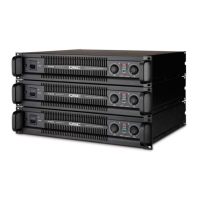PL3 Series Service Manual 41
TD-000274-00 Rev. A
Figure 3.10. Typical crossover residual from distortion analyzer
output
Faults With Signal Present
The customer complains that the amplifier passes a signal but
doesn’t run correctly.
Symptoms covered:
• Premature clipping (without load)
• Premature clipping (with load)
• Excessive distortion
• Runs too hot
• Unequal output in bridged mono mode
Fault: Premature clipping (without load)
• One of the step rails does not work. First inspect for broken or
damaged leads on the switching FETs and diodes Q41, Q38,
D21, and D22 (channel 1) and Q86, Q83, D47, and D46 (chan-
nel 2). If the FETs and diodes are okay, see
Troubleshooting Step
Problems
for in-depth troubleshooting.
• Defective clip limiting. See
Troubleshooting Clipping, Limiting
(Audio Power Stage).
Fault: Premature clipping (with load)
• Excessive current limiting into normal load. See
Troubleshooting
Current Limit (Audio Output).
Fault: Excessive distortion
Gain drops about 1 dB; a high-frequency oscillation is superimposed
on the audio signal.
• Inspect for damaged or burnt ground traces from the input and
display boards to the main board.
Excessive THD, greater than 0.1%.
• Make sure the main board, input, output, and display boards are
securely fastened to the chassis for proper grounding.
• See
Troubleshooting Stability Feedback.
Fault: Amplifier runs too hot
• Make sure the fan is working properly. It should speed up when
the amplifier gets warm. See
Troubleshooting Fan Speed
for in-
depth troubleshooting.
• Check the step FETs. If any is shorted, it will cause the amplifier
to run inefficiently. See
Troubleshooting Step Problems
for in-
depth troubleshooting.
• The bias may be set excessively high. Calibrate the bias on the
suspect channel as described in the test procedure. Figure 3.10
shows an acceptable crossover spike at the distortion analyzer
output.
Fault: Unequal output level in bridged mono
mode
• Check for shorted or damaged (burnt) diodes and transistors:
D50, D48, Q46, and Q42.
Troubleshooting Instructions
Power Supply: Troubleshooting TOP-210 bias
supply faults—overvoltage, undervoltage, or
no voltage
NOTE: The term “bias supply” refers to the small housekeeping
power supply that powers the control and switching circuitry in the
amplifier’s power supply. It does not involve the bias current in the
amplifier output sections.
Quick bias supply test
120 V models: Start with the variable transformer set to zero. Turn
up the AC voltage slowly to about 25% of the amplifier’s full
operating voltage (30 V). If the bias supply is working normally, the
green
POWER
LED should come on between 30 and 35 V, with its
usual steady half-brightness.
If the LED comes on early (at about 20 V), or late (about 50 V or
more), or blinks,
do not raise the AC past 60 V
until you first
3.2 PL325 and PL340: Symptoms, causes, and remedies (continued)

